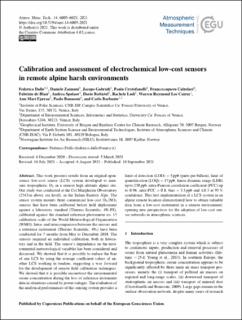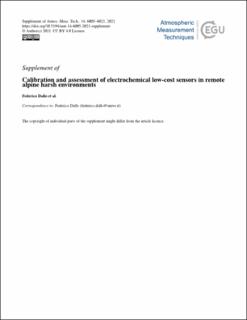| dc.contributor.author | Dallo, Frederico | |
| dc.contributor.author | Zannoni, Daniele | |
| dc.contributor.author | Gabrieli, Jacopo | |
| dc.contributor.author | Cristofanelli, Paolo | |
| dc.contributor.author | Calzolari, Francescopiero | |
| dc.contributor.author | de Blasi, Fabrizio | |
| dc.contributor.author | Spolaor, Andrea | |
| dc.contributor.author | Battistel, Dario | |
| dc.contributor.author | Lodi, Rachele | |
| dc.contributor.author | Cairns, Warren R. L. | |
| dc.contributor.author | Fjæraa, Ann Mari | |
| dc.contributor.author | Bonasoni, Paolo | |
| dc.contributor.author | Barbante, Carlo | |
| dc.date.accessioned | 2021-09-15T11:35:11Z | |
| dc.date.available | 2021-09-15T11:35:11Z | |
| dc.date.created | 2021-09-14T15:07:00Z | |
| dc.date.issued | 2021 | |
| dc.identifier.issn | 1867-1381 | |
| dc.identifier.uri | https://hdl.handle.net/11250/2777406 | |
| dc.description.abstract | This work presents results from an original open-source low-cost sensor (LCS) system developed to measure tropospheric O3 in a remote high altitude alpine site. Our study was conducted at the Col Margherita Observatory (2543 m above sea level), in the Italian Eastern Alps. The sensor system mounts three commercial low-cost O3/NO2 sensors that have been calibrated before field deployment against a laboratory standard (Thermo Scientific; 49i-PS), calibrated against the standard reference photometer no. 15 calibration scale of the World Meteorological Organization (WMO). Intra- and intercomparison between the sensors and a reference instrument (Thermo Scientific; 49c) have been conducted for 7 months from May to December 2018. The sensors required an individual calibration, both in laboratory and in the field. The sensor's dependence on the environmental meteorological variables has been considered and discussed. We showed that it is possible to reduce the bias of one LCS by using the average coefficient values of another LCS working in tandem, suggesting a way forward for the development of remote field calibration techniques. We showed that it is possible reconstruct the environmental ozone concentration during the loss of reference instrument data in situations caused by power outages. The evaluation of the analytical performances of this sensing system provides a limit of detection (LOD) <5 ppb (parts per billion), limit of quantification (LOQ) <17 ppb, linear dynamic range (LDR) up to 250 ppb, intra-Pearson correlation coefficient (PCC) up to 0.96, inter-PCC >0.8, bias >3.5 ppb and ±8.5 at 95 % confidence. This first implementation of a LCS system in an alpine remote location demonstrated how to obtain valuable data from a low-cost instrument in a remote environment, opening new perspectives for the adoption of low-cost sensor networks in atmospheric sciences. | en_US |
| dc.language.iso | eng | en_US |
| dc.publisher | Copernicus Publications | en_US |
| dc.rights | Navngivelse 4.0 Internasjonal | * |
| dc.rights.uri | http://creativecommons.org/licenses/by/4.0/deed.no | * |
| dc.title | Calibration and assessment of electrochemical low-cost sensors in remote alpine harsh environments | en_US |
| dc.type | Journal article | en_US |
| dc.type | Peer reviewed | en_US |
| dc.description.version | publishedVersion | en_US |
| dc.rights.holder | Copyright Author(s) 2021. | en_US |
| cristin.ispublished | true | |
| cristin.fulltext | original | |
| cristin.fulltext | original | |
| cristin.qualitycode | 1 | |
| dc.identifier.doi | 10.5194/amt-14-6005-2021 | |
| dc.identifier.cristin | 1934249 | |
| dc.source.journal | Atmospheric Measurement Techniques | en_US |
| dc.source.pagenumber | 6005-6021 | en_US |
| dc.relation.project | EC/H2020/844526 | en_US |
| dc.identifier.citation | Atmospheric Measurement Techniques. 2021, 14 (9), 6005-6021. | en_US |
| dc.source.volume | 14 | en_US |
| dc.source.issue | 9 | en_US |


